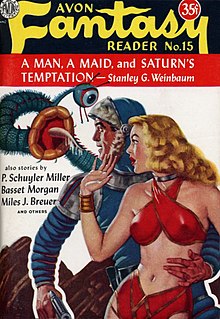
Weather is the state of the atmosphere, describing for example the degree to which it is hot or cold, wet or dry, calm or stormy, clear or cloudy. On Earth, most weather phenomena occur in the lowest layer of the planet's atmosphere, the troposphere, just below the stratosphere. Weather refers to day-to-day temperature, precipitation, and other atmospheric conditions, whereas climate is the term for the averaging of atmospheric conditions over longer periods of time. When used without qualification, "weather" is generally understood to mean the weather of Earth.
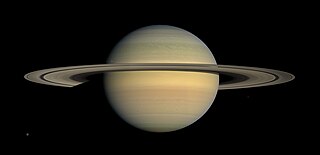
Saturn is the sixth planet from the Sun and the second-largest in the Solar System, after Jupiter. It is a gas giant with an average radius of about nine and a half times that of Earth. It has only one-eighth the average density of Earth; however, with its larger volume, Saturn is over 95 times more massive.

Titan is the largest moon of Saturn and the second-largest natural satellite in the Solar System. It is the only moon known to have a dense atmosphere, and is the only known object in space other than Earth on which clear evidence of stable bodies of surface liquid has been found.

Iapetus is a moon of Saturn. It is the 24th of Saturn’s 83 known moons. With an estimated diameter of 1,469 km, it is the third-largest moon of Saturn and the eleventh-largest in the Solar System. Named after the Titan Iapetus, the moon was discovered in 1671 by Giovanni Domenico Cassini.

An atmosphere is a layer of gas or layers of gases that envelop a planet, and is held in place by the gravity of the planetary body. A planet retains an atmosphere when the gravity is great and the temperature of the atmosphere is low. A stellar atmosphere is the outer region of a star, which includes the layers above the opaque photosphere; stars of low temperature might have outer atmospheres containing compound molecules.

Xanadu is a highly reflective area on the leading hemisphere of Saturn's moon Titan. Its name comes from an alternate transcription of Shangdu, the summer capital of the Yuan dynasty established by Kublai Khan and made famous by Samuel Taylor Coleridge.
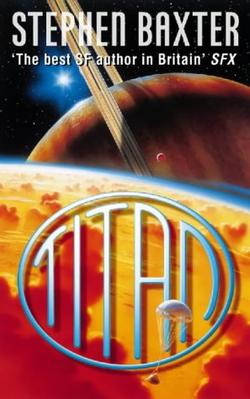
Titan is a 1997 science fiction novel by British writer Stephen Baxter. The book depicts a crewed mission to Titan — the enigmatic moon of Saturn — which has a thick atmosphere and a chemical makeup that some think may contain the building blocks of life. Titan was nominated for the Arthur C. Clarke Award in 1998.
"Parasite Planet" is a science fiction short story by American writer Stanley G. Weinbaum originally published in the February 1935 issue of Astounding Stories. It was Weinbaum's fourth published story, and the first to be set on Venus. He quickly followed it up with a sequel called "The Lotus Eaters".
"The Planet of Doubt" is a science fiction short story by American writer Stanley G. Weinbaum that was first published in the October 1935 issue of Astounding Stories. It is Weinbaum's third story featuring Hamilton Hammond and Patricia Burlingame, a sequel to "Parasite Planet" and "The Lotus Eaters".

Dicyanoacetylene, also called carbon subnitride or but-2-ynedinitrile (IUPAC), is a compound of carbon and nitrogen with chemical formula C4N2. It has a linear molecular structure, N≡C−C≡C−C≡N, with alternating triple and single covalent bonds. It can be viewed as acetylene with the two hydrogen atoms replaced by cyanide groups.
The Planetary series of stories by Stanley G. Weinbaum is a series of short stories, published in Wonder Stories and Astounding Stories in the 1930s, which are set upon various planets and moons of the Solar System.

Whether there is life on Titan, the largest moon of Saturn, is currently an open question and a topic of scientific assessment and research. Titan is far colder than Earth, but of all the places in the Solar System, Titan is the only place besides Earth known to have liquids in the form of rivers, lakes, and seas on its surface. Its thick atmosphere is chemically active and rich in carbon compounds. On the surface there are small and large bodies of both liquid methane and ethane, and it is likely that there is a layer of liquid water under its ice shell. Some scientists speculate that these liquid mixes may provide prebiotic chemistry for living cells different from those on Earth.

The atmosphere of Titan is the dense layer of gases surrounding Titan, the largest moon of Saturn. It is the only thick atmosphere of a natural satellite in the Solar System. Titan's lower atmosphere is primarily composed of nitrogen (94.2%), methane (5.65%), and hydrogen (0.099%). There are trace amounts of other hydrocarbons, such as ethane, diacetylene, methylacetylene, acetylene, propane, PAHs and of other gases, such as cyanoacetylene, hydrogen cyanide, carbon dioxide, carbon monoxide, cyanogen, acetonitrile, argon and helium. The isotopic study of nitrogen isotopes ratio also suggest acetonitrile may be present in quantities exceeding hydrogen cyanide and cyanoacetylene. The surface pressure is about 50% higher than on Earth at 1.5 bars which is near the triple point of methane and allows there to be gaseous methane in the atmosphere and liquid methane on the surface. The orange color as seen from space is produced by other more complex chemicals in small quantities, possibly tholins, tar-like organic precipitates.

The habitability of natural satellites is a measure of their potential to sustain life in favorable circumstances. Habitable environments do not necessarily harbor life. Natural satellite habitability is a new area that is significant to astrobiology for various reasons, the most important of which being that natural satellites are expected to outnumber planets by a large margin, and it is projected that habitability parameters will be comparable to those of planets. There are, nevertheless, significant environmental variables that affect moons as prospective alien life locations. The strongest candidates for natural satellite habitability are currently icy satellites such as those of Jupiter and Saturn—Europa and Enceladus respectively, although if life exists in either place, it would probably be confined to subsurface habitats. Historically, life on Earth was thought to be strictly a surface phenomenon, but recent studies have shown that up to half of Earth's biomass could live below the surface. Europa and Enceladus exist outside the circumstellar habitable zone which has historically defined the limits of life within the Solar System as the zone in which water can exist as liquid at the surface. In the Solar System's habitable zone, there are only three natural satellites—the Moon, and Mars's moons Phobos and Deimos —none of which sustain an atmosphere or water in liquid form. Tidal forces are likely to play as significant a role providing heat as stellar radiation in the potential habitability of natural satellites.
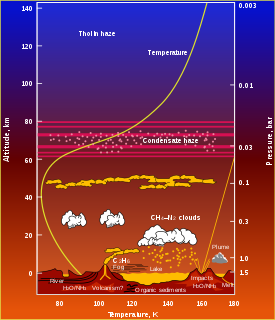
The climate of Titan, the largest moon of Saturn, is similar in many respects to that of Earth, despite having a far lower surface temperature. Its thick atmosphere, methane rain, and possible cryovolcanism create an analogue, though with different materials, to the climatic changes undergone by Earth during its far shorter year.

Spacehounds of IPC is a science fiction novel by American writer E. E. Smith. It was first published in book form in 1947 by Fantasy Press in an edition of 2,008 copies. It was the first book published by Fantasy Press. The novel was originally serialized in the August, September and October issues of the magazine Amazing Stories in 1931. Smith was disenchanted when he saw editor T. O'Conor Sloane's unauthorized changes in the story, most likely made to give equal length to each of the three parts it had been split into.

Ligeia Mare is a lake in the north polar region of Titan, the planet Saturn's largest moon. It is the second largest body of liquid on the surface of Titan, after Kraken Mare. Larger than Lake Superior on Earth, it is mostly composed of liquid methane, with unknown but lesser components of dissolved nitrogen and ethane, as well as other organic compounds. It is located at 78° N, 249° W, and has been fully imaged by the Cassini spacecraft. Measuring roughly 420 km (260 mi) by 350 km (217 mi) across, it has a surface area of about 126,000 km2, and a shoreline over 2,000 km (1,240 mi) in length. The lake may be hydrologically connected to the larger Kraken Mare. Its namesake is Ligeia, one of the sirens in Greek mythology.
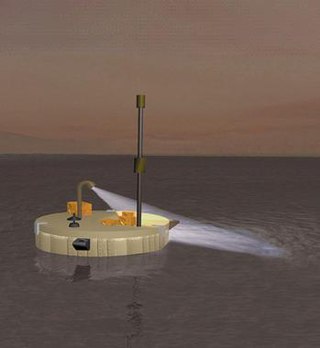
Titan Mare Explorer (TiME) is a proposed design for a lander for Saturn's moon Titan. TiME is a relatively low-cost, outer-planet mission designed to measure the organic constituents on Titan and would have performed the first nautical exploration of an extraterrestrial sea, analyze its nature and, possibly, observe its shoreline. As a Discovery-class mission it was designed to be cost-capped at US$425 million, not counting launch vehicle funding. It was proposed to NASA in 2009 by Proxemy Research as a scout-like pioneering mission, originally as part of NASA's Discovery Program. The TiME mission design reached the finalist stage during that Discovery mission selection, but was not selected, and despite attempts in the U.S. Senate failed to get earmark funding in 2013. A related Titan Submarine has also been proposed.
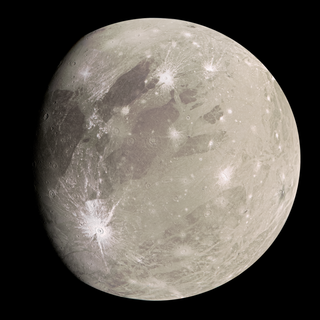
An ice planet or icy planet is a type of planet with an icy surface of volatiles such as water, ammonia, and methane. Ice planets consist of a global cryosphere.
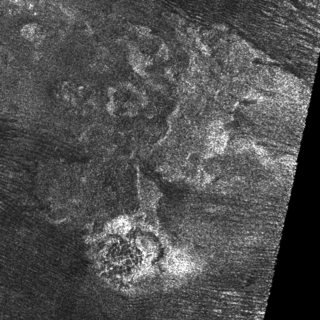
Doom Mons is the name of a mountain range and its eponymous peak on Titan, the largest moon of Saturn. A putative cryovolcano, it is the largest mountain range on Titan by volume, and at 4,757 ft (1,450 m) one of the highest in the Solar System. It was discovered by the Cassini–Huygens probe in 2005 and officially named in 2012.
